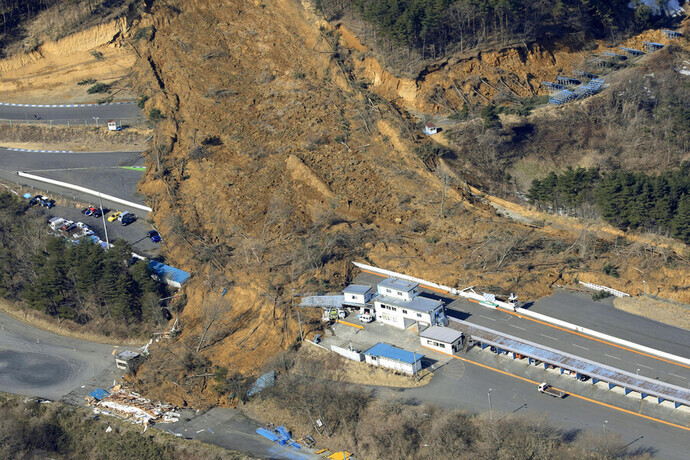hankyoreh
Links to other country sites 다른 나라 사이트 링크
Fukushima spillage raises questions about threat of future earthquakes

The occurrence of a 7.3-magnitude earthquake in the waters off of Fukushima on Feb. 13 is prompting growing concerns about the safety of the Fukushima Daiichi Nuclear Power Plant, as some mention the possibility of other quakes at a similar scale.
Experts said that with no way of knowing how large future earthquakes will be, swift preparations are needed to prevent damage to the plant.
According to reporting by Japan’s NHK television network on Feb. 15, the Japanese government’s Earthquake Survey Committee stressed the need to be on the alert over the next week or so for earthquakes at a “strong 6” on the Japanese seismic intensity scale. The warning suggested the possibility of additional quakes on par with the one on Feb. 13, which was a strong 6.
“We need to prepare,” the committee said, noting the possibility of eastern Japan being “ambushed by strong vibrations and/or a tsunami caused by a large-scale earthquake.”
In an interview with NHK, Tohoku University professor Shinji Toda said there was the “possibility of a 9.0-magnitude earthquake and tsunami occurring in the waters off of Fukushima and Miyagi, as well as the north and south of the area where the [2011 Tohoku] earthquake occurred 10 years ago and the area outside of the Japan Trench.”
Hong Tae-kyung, a professor of earth system sciences at Yonsei University, warned that the associated ground motion could be large relative to the scale of the earthquake itself.
“The scale of this earthquake was within a predictable level for the region, but the fact that the ground motion was so much larger gives pause,” he explained.
“Ground motion differs according to earthquake scale, sedimentary layer thickness, observation position and other factors, and it’s common for ground motion to be larger near the coast due to the sedimentary layer’s thickness. But even when you take all of that into account, the ground motion was very large,” he said.
“There’s a possibility the ground motion exceeded what the Fukushima nuclear power plant could withstand in terms of its design.”
With predictions that additional large-scale earthquakes could occur, observers are calling for swift preparations to prevent damage to the Fukushima plant. According to Kyodo News and other Japanese media, some spillage was determined to have occurred during the earthquake in tanks holding spent nuclear fuel at the upper layers of the No. 5 and 6 reactors at the Fukushima plant.
Japanese nuclear power authorities and the Tokyo Electric Power Company (TEPCO), which operates the plant, stated that there had been no radiation exposure as a result of the tank spillage.
Institute of Nuclear Safety director Han Byeong-seop agreed that the “nuclear power plant safety issues resulting from the earthquake were not at a concerning level,” but stressed the “need to prepare for a compound disaster in the wake of an earthquake.”
“The amount of water that spilled from the spent nuclear fuel in this earthquake was minute, so it wasn’t at a worrisome level, and there does not appear to have been any damage to the power plant,” he said.
“But with the Tohoku earthquake in 2011, there was major damage resulting from a compound disaster involving both an earthquake and tsunami, and there’s no way of predicting the scale of additional earthquakes that we might see this time,” he added.
“There need to be continued preparations for a compound disaster.”
Oh Chang-whan, a professor of earth and environmental sciences at Jeonbuk National University, said, “Nuclear power plants are designed to be safe during earthquakes, yet even so we saw issues with water spillage.”
“Nobody can predict for certain what kind of damage an earthquake or tsunami might cause. We need to prepare,” he urged.
By Kim Min-je, staff reporter
Please direct comments or questions to [english@hani.co.kr]

Editorial・opinion
![[Guest essay] Amending the Constitution is Yoon’s key to leaving office in public’s good graces [Guest essay] Amending the Constitution is Yoon’s key to leaving office in public’s good graces](https://flexible.img.hani.co.kr/flexible/normal/500/300/imgdb/original/2024/0416/8917132552387962.jpg) [Guest essay] Amending the Constitution is Yoon’s key to leaving office in public’s good graces
[Guest essay] Amending the Constitution is Yoon’s key to leaving office in public’s good graces![[Editorial] 10 years on, lessons of Sewol tragedy must never be forgotten [Editorial] 10 years on, lessons of Sewol tragedy must never be forgotten](https://flexible.img.hani.co.kr/flexible/normal/500/300/imgdb/original/2024/0416/8317132536568958.jpg) [Editorial] 10 years on, lessons of Sewol tragedy must never be forgotten
[Editorial] 10 years on, lessons of Sewol tragedy must never be forgotten- [Column] A death blow to Korea’s prosecutor politics
- [Correspondent’s column] The US and the end of Japanese pacifism
- [Guest essay] How Korea turned its trainee doctors into monsters
- [Guest essay] As someone who helped forge Seoul-Moscow ties, their status today troubles me
- [Editorial] Koreans sent a loud and clear message to Yoon
- [Column] In Korea’s midterm elections, it’s time for accountability
- [Guest essay] At only 26, I’ve seen 4 wars in my home of Gaza
- [Column] Syngman Rhee’s bloody legacy in Jeju
Most viewed articles
- 1[Guest essay] Amending the Constitution is Yoon’s key to leaving office in public’s good graces
- 2Faith in the power of memory: Why these teens carry yellow ribbons for Sewol
- 3[Editorial] 10 years on, lessons of Sewol tragedy must never be forgotten
- 4Final search of Sewol hull complete, with 5 victims still missing
- 5[Guest essay] How Korea turned its trainee doctors into monsters
- 6How Samsung’s promises of cutting-edge tech won US semiconductor grants on par with TSMC
- 7Pres. Park an accomplice in ordering resignation of CJ Group vice chairman
- 8[News analysis] Watershed augmentation of US-Japan alliance to put Korea’s diplomacy to the test
- 9K-pop a major contributor to boom in physical album sales worldwide, says IFPI analyst
- 10Korea ranks among 10 countries going backward on coal power, report shows